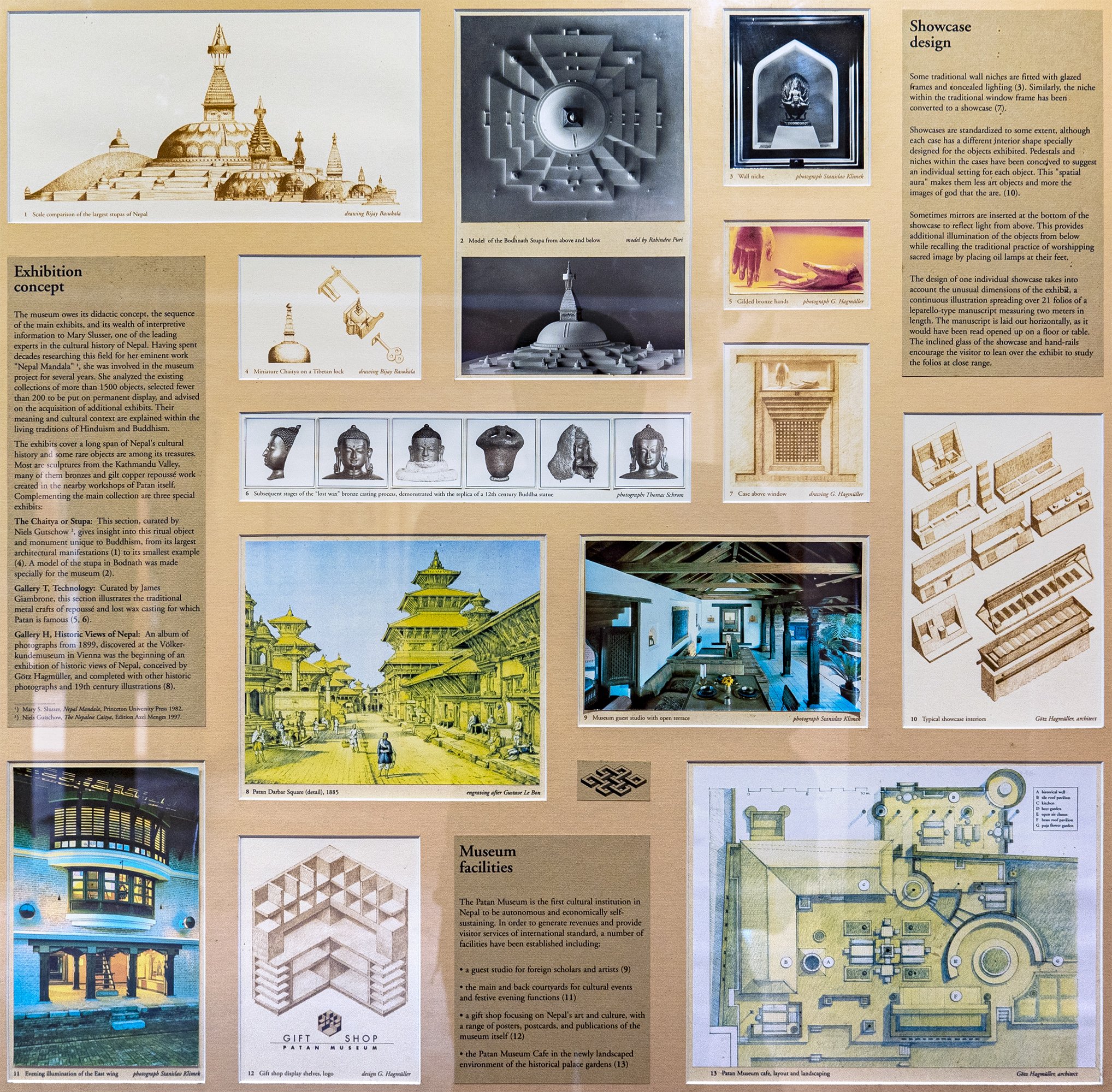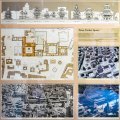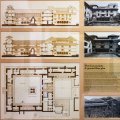Patan Museum (Nepal): photo 2
Photo 2 of 212 in Gallery: Patan Museum (Nepal)

Image title: Chaitya or Stupas of Nepal
Description of the photo
Exhibition concept—The museum owes its didactic concept, the sequence of the main exhibits, and its wealth of interpretive information to Mary Slusser, one of the leading experts in the cultural history of Nepal. Having spent decades researching this field for her eminent work "Nepal Mandala", she was involved in the museum project for several years. She analyzed the existing collections of more than 1500 objects, selected fewer than 200 to be put on permanent display, and advised on the acquisition of additional exhibits. Their meaning and cultural context are explained within the living traditions of Hinduism and Buddhism.
The exhibits cover a long span of Nepal’s cultural history and some rare objects are among its treasures. Most are sculptures from the Kathmandu Valley, many of them bronzes and gilt copper repoussé work created in the nearby workshops of Patan itself. Complementing the main collection are three special exhibits:
The Chaitya or Stupa: This section, curated by Niels Gutschow, gives insight into this ritual object and monument unique to Buddhism, from its largest architectural manifestations (1) torits smallest example (4). A model of the stupa in Bodnath was made specially for the museum (2).
Gallery T, Technology: Curated by James Giambrone, this section illustrates the traditional metal crafts of repoussé and lost wax casting for which Patan is famous (5, 6).
Gallery H, Historic Views of Nepal: An album of photographs from 1899, discovered at the Völker- kundemuseum in Vienna was the beginning of an exhibition of historic views of Nepal, conceived by Götz Hagmüller, and completed with other historic photographs and 19th century illustrations (8).
Showcase design—Some traditional wall niches are fitted with glazed frames and concealed lighting (3). Similarly, the niche within the traditional window frame has been converted to a showcase (7).
Showcases are standardized to some extent, although each case has a different interior shape specially designed for the objects exhibited. Pedestals and niches within the cases have been conceived to suggest an individual setting for each object. This "spatial aura" makes them less art objects and more the images of god that the are. (10).
Sometimes mirrors are inserted at the bottom of the showcase to reflect light from above. This provides additional illumination of the objects from below while recalling the traditional practice of worshipping sacred image by placing oil lamps at their feet.
The design of one individual showcase takes into account the unusual dimensions of the exhibit, a continuous illustration spreading over 21 folios of a leparello-type manuscript measuring two meters in length. The manuscript is laid out horizontally, as it would have been read opened up on a floor or table. The inclined glass of the showcase and hand-rails encourage the visitor to lean over the exhibit to study the folios at close range.
Museum facilities—The Patan Museum is the first cultural institution in Nepal to be autonomous and economically self- sustaining. In order to generate revenues and provide visitor services of international standard, a number of facilities have been established including:
-) a guest studio for foreign scholars and artists (9)
-) the main and back courtyards for cultural events and festive evening functions (11)
-) a gift shop focusing on Nepal's art and culture, with a range of posters, postcards, and publications of the museum itself (12)
-) the Patan Museum Cafe in the newly landscaped environment of the historical palace gardens (13)
Transcriptions:
1) Scale comparison of the largest Stupas of Nepal;—drawing Bijay Basukala.
2) Model of the Bodhnath Stupa from above and below;—model by Rabindra Puri
3) Wall niche—photograph Stanislav Klimek.
4) Miniature Chaitya on a Tibetan lock;—drawing Bijay Basukala.
5) Gilded bronze hands;—photograph G. Hagmüller
6) Subsequent stages of the "lost wax" bronze casting process, demonstrated with the replica of a 12th century Buddha statue;—photograph Thomas Schrom
7) Case above window;—drawing G. Hagmüller.
8) Patan Darbar Square (detail)—engraving after Gustave Le Bon.
9) Museum guest studio with open terrace—photograph Stanislav Klimek.
10) Typical showcase interiors—Götz Hagmüller, architect.
11) Evening illumination of the East wing—photograph Stanislav Klimek.
12) Gift shop display shelve, logo—design G. Hagmüller.
13) Patan Museum cafe, layout and landscaping—Götz Hagmüller, architect.
Gallery information:
The Patan Museum is located on the Durbar square of Patan (Lalitpur/Lalitapura, Kathmandu, Nepal) which is associated Keshav Narayan Chowk (Keshavnarayan)—a form of Lord Vishnu. Being listed as a World Heritage Site, the whole of Durbar square is filled with exquisite temples, sculptures and other ancient structures, of which the ancient history history can be traced to the Malla Kings of Lalitpur. It is an important site for both Buddhism and Hinduism.
Photo details:
Date: 2019-12-02
Camera: SONY ILCE-6400
Exposure: 1/20
Aperture: f/4
ISO: 100
Focal length: 18mm
High resolution:
Download file
Size: 2.47 MB
Resolution: 2036 x 2000
© Photograph by Gabe Hiemstra.
License: CC BY-NC-ND 4.0

